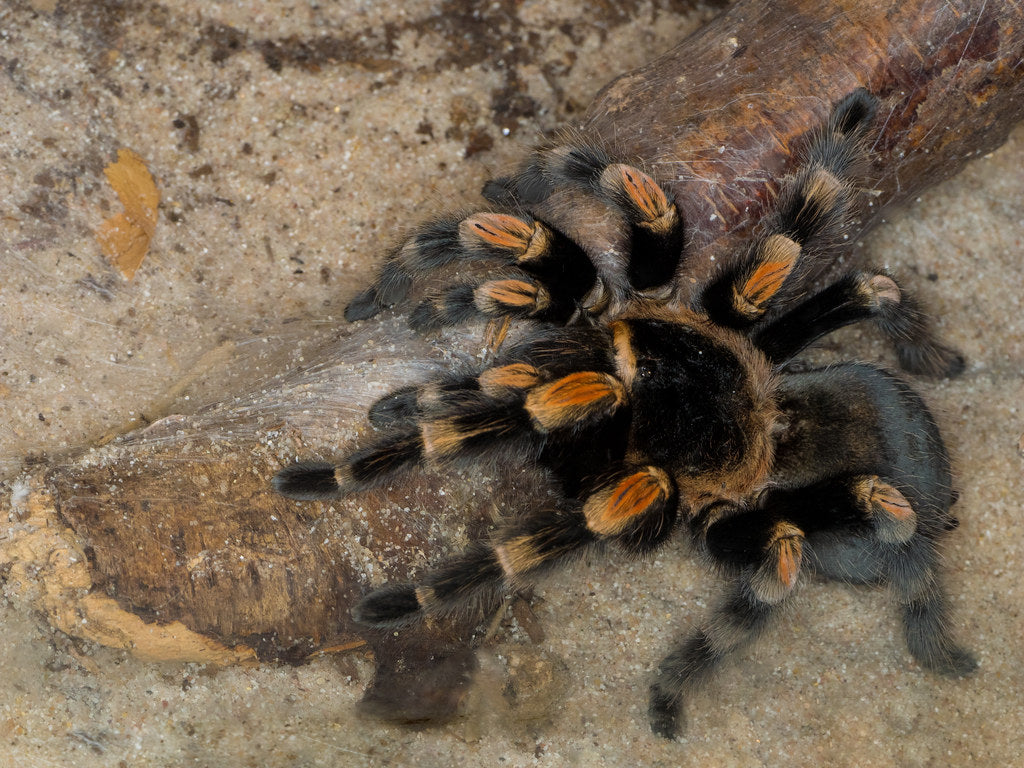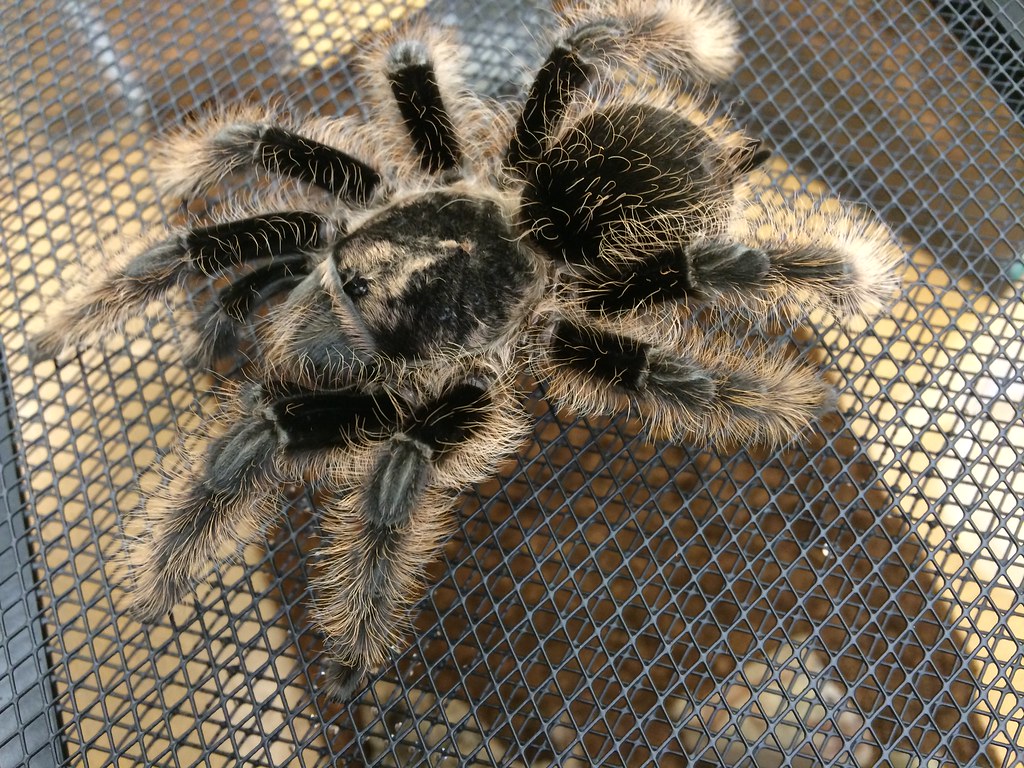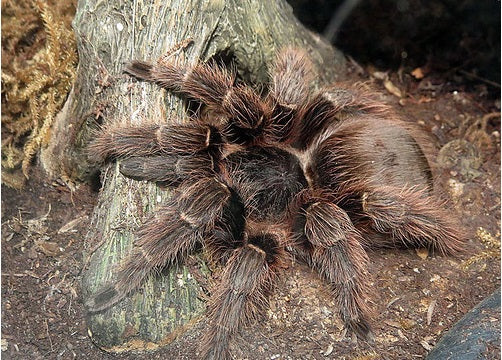The Mexican red knee tarantula (Brachypelma smithi) is a medium-sized, nocturnal, terrestrial tarantula found in eastern Mexico. Their preferred habitats are desert and scrub, although they can also be found in forest environments.
Mexican red knee tarantulas typically have a 5.5-6.5” legspan as adults. Their body has a brown-black base color with red or orange hairs on the joints of their legs. They do possess urticating hairs, but use them infrequently.
Mexican red knee tarantulas are known for being a great beginner-level tarantula because of their docile dispositions and generally hardiness, although they are still fairly skittish. With good care, males can be expected to live up to 10 years, while females may live well beyond 15 years.
How much space do Mexican red knee tarantulas need?
Mexican red knee tarantulas don’t need much space, but they do need at least some space for moving around. The minimum for appropriately keeping one adult Mexican red knee tarantula is 20”L x 10”W x 10”H, or the equivalent of a standard 10-gallon tank.
It’s best not to house slings in adult-sized enclosures. Instead, basic acrylic spiderling enclosures are usually suitable, no less than four times the spider’s legspan, and no taller than two legspans above the substrate layer.
Cohabitation (keeping multiple tarantulas in one enclosure) is not recommended, as cannibalism is possible.
Do Mexican red knee tarantulas need UVB?
They can certainly survive without it, and due to this fact, as well as the fact that UVB wavelengths are blocked by glass and acrylic lids, UVB is not commonly used among tarantula keepers.
That being said, there is some evidence to suggest that tarantulas may benefit from UVB lighting when appropriately provided. This paper speculates that wild tarantulas may get at least part of their vitamin D3 from UVB exposure, and this paper provides evidence of invertebrates being able to synthesize vitamin D3 from UVB.
If you wish to provide UVB to your (adult) tarantula, the best UVB bulb to use is likely to be the compact coil Zoo Med Reptisun 5.0, 13w. The bulb should be mounted horizontally in a reflective fixture, and placed on top of a mesh lid. UVB bulb output decays over time, so make sure to replace your bulb every 6 months.
Lights should be on for 12 hours/day.
What temperatures do Mexican red knee tarantulas need?
Tarantulas are ectotherms, which means that they need to be kept within a specific range of temperatures in order to regulate their metabolism and stay healthy.
The optimal ambient temperature for Mexican red knee tarantulas is between 70-80°F during the day. If possible, try to maintain your tarantula’s room between 74-76°F. However, if this is not possible, and the room is cooler than this range, then you’ll need a heat source. A small heat mat, stuck to the side of the enclosure and regulated with a thermostat set to 80-82°F during the day, should be enough to address this problem.
Track the temperatures in your enclosure with a digital probe thermometer.
What humidity levels do Mexican red knee tarantulas need?
Mexican red knee tarantulas generally prefer moderate humidity conditions between 40-60%, occasionally rising to 80%. You can do this by making the substrate very slightly moist in a sling enclosure, and keep one half of the substrate moistened and one half dry for adults.
Measure the ambient humidity levels with a digital probe hygrometer.
What substrate is good for Mexican red knee tarantulas?
Mexican red knee tarantulas are known to burrow, particularly as slings. Slings should have 2-3” of substrate, and adults should have at least 4”. We recommend the following substrates for Mexican red knee tarantulas:
What décor can you use in a Mexican red knee tarantula terrarium?
Tarantulas may not seem to do much, but it’s still beneficial to give them items in their enclosure that they can explore and use to express natural behaviors. It also makes the enclosure more attractive!
At minimum, your tarantula needs at least one place to hide. However, additional options include:
- low branches
- cork flats and tubes
- live or artificial plants
- artificial ornaments
What do Mexican red knee tarantulas eat?
Tarantulas are carnivores, which means that they need whole prey in order to get the nutrition that they need. Here is a basic feeding schedule:
- Juveniles — once per week
- Adults — every other week
Tarantulas should receive 1-5 bugs per meal, depending on their body condition and the nutritional density of the insect (ex: one dubia roach is usually worth multiple crickets). Prey insects should be small enough for the tarantula to overpower, which is an especially important consideration for slings — this is usually roughly the same size or smaller than the length of the tarantula’s abdomen. Monitor your tarantula’s physical condition and offer more or less food accordingly.
Live, well-gutloaded prey is a requirement. Offer a variety of different insects if possible to provide varied nutrition:
- Black crickets
- Black soldier fly larvae
- Brown crickets
- Dubia roaches
- Discoid roaches
- Flightless fruit flies (for slings)
- Mealworms
- Red runner roaches
Remove all uneaten prey within 24 hours to prevent the prey from harassing the tarantula. Never offer prey within 2 weeks after a molt.
Water
Tarantulas under 2” across should receive water via routine (light) misting of the enclosure. The enclosure should be allowed to dry between mistings. Tarantulas over 2” may have a shallow water dish for drinking. Change the water daily and scrub the bowl with a reptile-safe disinfectant weekly.
Do Mexican red knee tarantulas like to be handled?
As a general rule, it’s best not to handle tarantulas. But as far as tarantulas go, Mexican red knee tarantulas can tolerate occasional handling well. Some are skittish and readily shoot urticating hairs, but others are calmer. Get to know your individual tarantula and respect its preferences.
Never handle a tarantula within a week of molting, and always handle it over a soft surface (ex: your bed or couch) so that if it falls, it won’t get injured.
*This care sheet contains only very basic information. Although it’s a good introduction, please do further research with high-quality sources to obtain additional information on caring for this species.
"Mexican Red Knee Tarantula" by wwarby is licensed under CC BY 2.0




Leave a comment
This site is protected by hCaptcha and the hCaptcha Privacy Policy and Terms of Service apply.